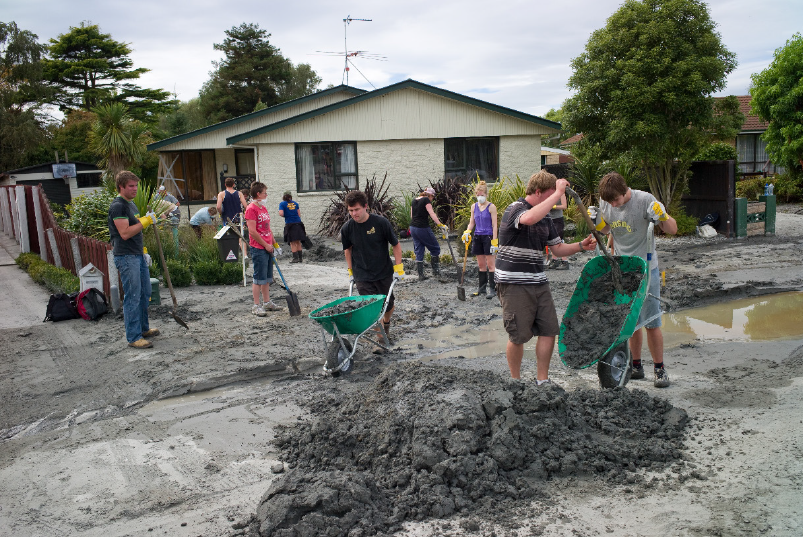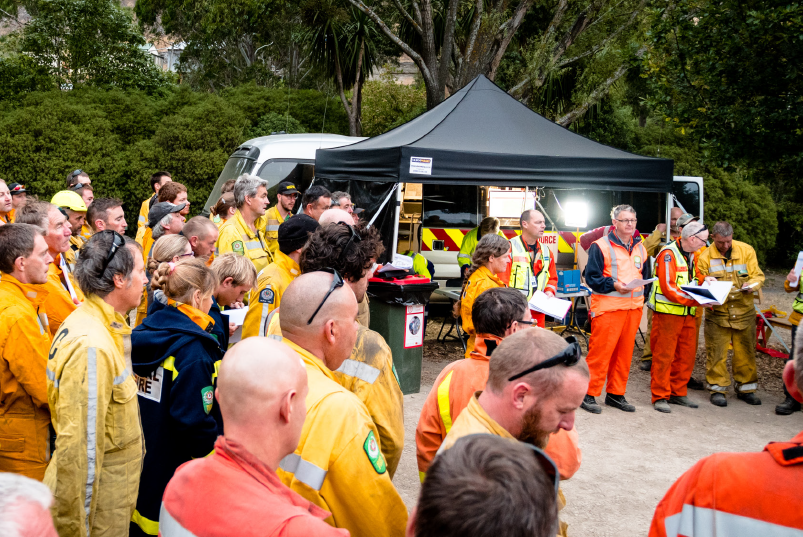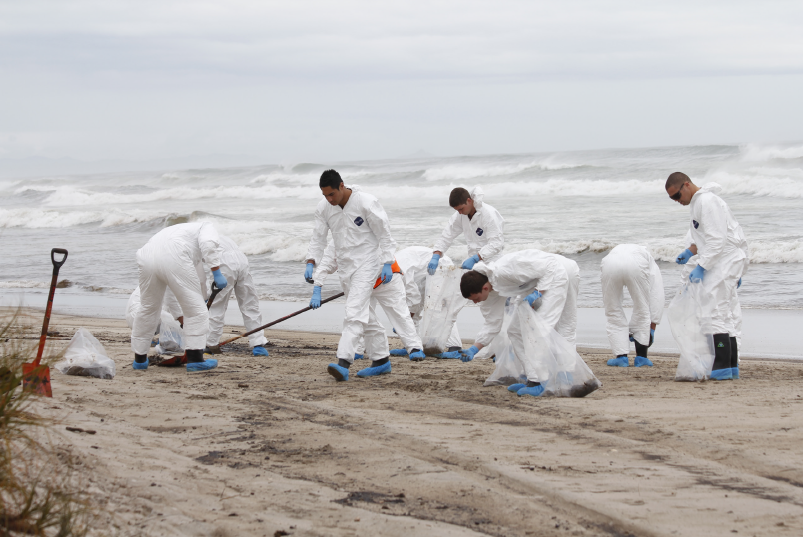In New Zealand, the social contribution of volunteers exceeds 270 million hours per year. Volunteer participation is a vital component of emergency services activities, particularly in rural settings. Fire and Emergency New Zealand is the primary rural emergency response agency with a network encompassing almost 3500 volunteers. This ‘formal’ volunteer capacity aids the wellbeing of communities, particularly in response to wildfire, but also other hazards. Formal organisation of volunteers is supplemented by informal volunteering, especially during response and recovery phases and is increasingly encouraged in readiness and reduction activities. Informal volunteering, evident in the ‘spontaneous’ mobilisation of resources during disasters, can evolve into more formal structures. Governments and volunteer organisations are being urged to plan for ‘spontaneous’ and ‘digital’ volunteers as part of their emergency preparedness to include volunteers in ways where formal and informal volunteering can work together. This paper considers the practical aspects of integrating informal and formal volunteers to identify lessons for inclusion. The papers examines how informal volunteer activities could contribute more to rural community resilience before, during and after emergency events.
Introduction
Volunteering increasingly attracts interest from governments in their recognition of the role volunteers play in the community as well as the voice of change. Volunteers champion causes for the benefit of civil society that may otherwise be neglected or unattended by the public sector (United Nations 2012). The role of volunteers spans many aspects of social, health and emergency service to communities. These include supporting vulnerable people in crisis or hazardous situations (e.g. Red Cross, State Emergency Services in Australia) as well as protecting endangered species and habitats from ecological destruction and environmental harm (e.g. Conservation Volunteers, Greenpeace, Environmental Defence Society in New Zealand). With the increasing number of extreme events accompanying changes in climate, including more severe storms, frequent and intense cyclonic events, flooding and wildfires (Aldunce et al. 2015), there is increased need for volunteers during emergency situations (Brennan, Flint & Barnett 2005, O’Brien 2008).
Within this context, there is a need for volunteer participation in readiness and reduction activities; not just response and recovery. Governments recognise the importance of volunteers in general and encourage volunteer services where resources are limited. Evidence shows that some governments offer incentives to support volunteer activities and organisations (Department of Internal Affairs n.d., Emergency Management Victoria 2015). Volunteers are also changing due to the pressures of work and family life that compete with unpaid work activities (Whittaker, McLennan & Handmer 2015, Heathrose 2013, Smith & Cordery 2010). A shift in practice towards informal and less traditional or more casual approaches to volunteering in emergency and disaster situations is increasing spontaneous grass roots or community-driven action (McLennan, Whittaker & Handmer 2016, United Nations 2015).
In New Zealand, the social contribution of volunteer work equates to over 270 million hours per year (Volunteering New Zealand 2016). Such voluntary participation is a vital component of emergency services within New Zealand, particularly in rural settings. According to Heathrose (2013):
In New Zealand there are 193 registered Volunteer Rural Fire Forces (VRFF) with approximately 3,500 volunteers. These forces respond to varying numbers of callouts, support their near-by urban forces, assist with road-related incidents and be the front-line response to protect property and life for over 96% of New Zealand’s land area.
(Heathrose, 2013)
This paper discusses some of the challenges associated with volunteering in New Zealand’s multi-hazards environment. Previous research commissioned by the former Fire and Emergency Services (now Fire and Emergency New Zealand) focused on recruitment and retention of rural firefighting volunteers (Heathrose 2013, Kan 2003, UMR Research 2001). This research moves that focus to include approaches that support informal volunteering and contribute to the resilience of rural communities in New Zealand.
Method
A review was undertaken of 88 online documents and 53 peer-reviewed journal articles reporting volunteering research and practice within organisations and across natural hazard settings in New Zealand and internationally. While the review was to support research into the role of non-traditional rural fire volunteers in building community resilience, aspects of integrating formal and informal volunteers were uncovered. Vignettes (brief illustrative descriptions) are provided as lessons to guide the integration of formal and informal volunteers.
This research:
- builds a picture of the changing context of volunteering in New Zealand
- considers what Fire and Emergency New Zealand and other response agencies can learn from local and
- international natural hazard experiences
identifies how formal and informal volunteering can be integrated as part of building community resilience to local hazards.
Defining ‘volunteers’ has limitations
Volunteering has a long tradition of practice in New Zealand and has evolved as a result of changing socio-political circumstances, social needs and hazard events (Smith & Cordery 2010). The New Zealand 2012 Census (Statistics New Zealand 2012) considers ‘volunteering’ to be activities undertaken for groups or organisations (i.e. formal volunteering). However, Volunteering New Zealand (2016), the peak body organisation for volunteers, defines volunteering1 as ‘any activity in which time is given freely to benefit another person, group or organisation’ (Wilson & Musick 2000, p.215). This encompasses a broad range of activities not formalised by membership in volunteer organisations such as Fire and Emergency New Zealand. A such, volunteering includes unpaid work outside one’s household, such as care giving and helping friends and neighbours with tasks. It may be spontaneous or planned; on one occasion or on a regular basis.
New Zealand is a bi-cultural nation with Treaty of Waitangi partnership between Māori (the Indigenous people) and the Crown. The official Indigenous language, Te Reo Māori, has no direct equivalent term for ‘volunteering’. Instead, Māori have a concept of sharing, termed mahi aroha, which is based on kinship (whanaungatanga) and the individual and the collective benefits of contributing to the common good (Office for the Community and Voluntary Sector 2007).
In this paper, formal volunteers are those who require membership of an organisation to receive training and liability protections through compliance rules. Informal volunteering comprises a range of other activities that do not meet such criteria and includes casual volunteering at fundraising events, spontaneous volunteering during a crisis and emergency events (also referred to as episodic volunteering) and emergent volunteering made possible through new technologies such as social media or through new kinds of need. In this paper, traditional and non-traditional volunteers reflect the changes in volunteer practices and activities.
Effects of government policy
Retention of volunteers interests volunteer organisations and governments due to the increasing economic and social benefit that the volunteer sector provides (Volunteering New Zealand 2016). Training is recognised as an important contributing factor for retaining volunteers, as well as increasing the quality of service provided by volunteers, which often depends on resourcing and management capacities (Kilpatrick, Stirling & Orpin 2010). However, some underlying factors of why fire volunteers feel poorly supported and undervalued by their organisations stem from the level of communication skills of paid staff (Johnstone 2002) and the limited recognition of volunteer contribution by employers and members of the community (Kan 2003). Such concerns have influenced governments in Australia and New Zealand. Recent strategies aim to promote awareness of volunteering and provide incentives for employers to support volunteers (Australia-New Zealand Emergency Management Council 2015).
In their examination of literature to establish how to best enhance volunteering, Haski-Leventhal, and colleagues (2010) found on four reasons for governments to promote volunteering:
- Volunteers enjoy positive life benefits from volunteering.
- Volunteering enhances social capital and social cohesion.
- Volunteering can allow for more affordable and better-quality service provision.
- Volunteering improves democratic processes by increasing citizen participation (Haski-Leventhal, Meijs & Hustinx 2010).
Governments can influence volunteering in a variety of ways. These include legislative initiatives to make volunteering more accessible, publicly recognising volunteers and protecting volunteers (Haski-Leventhal, Meijs & Hustinx 2010). Governments can also support volunteers by making volunteering activities more acceptable and volunteer service attractive to employers as well as increasing community awareness of the contribution made by volunteers (Haski-Leventhal, Meijs & Hustinx 2010). Australian studies into volunteering and family life have recommended government initiatives ease the financial burden on volunteers, their families and employers that are directly associated with emergency services volunteering (McLennan & Birch 2009). Vignette 1 is an example of other ways governments can support volunteer recruitment and retention (McLennan, Whittaker & Handmer 2016).





